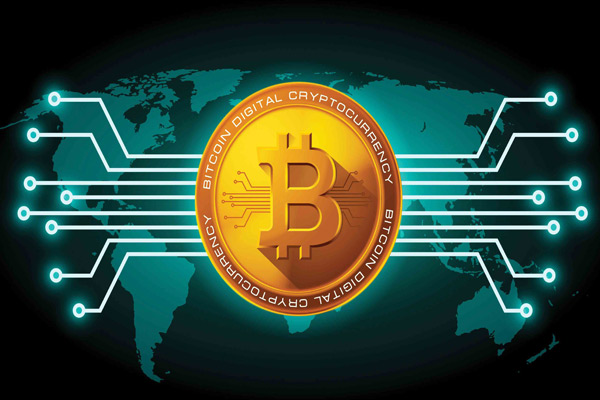IT’S either the biggest fraud in financial history or the biggest revolution in human civilisation. In a few years, it will either trade for peanuts or, as one estimate puts it, sell for $100,000, that is, seven times its present worth. It can be a boon or bane, caught in a cycle of a boom or bubble. The saga of bitcoin, one of the unregulated crypto-currencies in circulation, is unfolding bit by bit, through volatile ups and downs and by additions and subtractions of zeroes.
The year 2017, however, was a magical and dream-like year for bitcoin. In the first week of January its worth hovered just about $800. In less than 11 months, by the beginning of December, it had catapulted to $17,550, or 21 times higher. And then it crashed to under $14,000 by the beginning of this year. It was a financial tsunami that shocked and awed everyone. No one knew why. In retrospect, there were several theories. In retrospect, Black Swans are always predictable.
However, the real problems with bitcoin are not its volatility and wild swings. The critical issues relate to governance and regulation. For instance, consider the recent statement by Indian Finance Minister Arun Jaitley. He clarified that the crypto-currency wasn’t a legal tender in the country. In addition, it was like a ponzi scheme with no regulatory protection. He added that the government was awaiting a committee report before taking a decision.

This is shocking for a finance minister to admit that something illegal was happening in the country and that he could do nothing about it. All he could do was to caution the buyers. “There is a real and heightened risk of investment bubble… which can result in sudden and prolonged cash exposing investors, especially retail customers losing their hard-earned money. Consumers need to be alert and extremely cautious as to avoid getting trapped.”
It’s highly improbable that the finance minister has no clue about the bitcoin craze in India. The pyramid-marketing system, which is successfully adopted by the global retail giant, Amway, and being debated in the country’s courts, has seeped into crypto-currency. Thousands of Indians have invested their life-savings to earn bitcoins, and hope to make a killing in the future. Although figures aren’t available, the market for this pyramid scheme is huge.
2017 was a magical and dream-like year for bitcoin. In the first week of January its worth hovered just about $800. By the beginning of December, it had catapulted to $17,550, or 21 times higher. And then it crashed to under $14,000 by the beginning of this year
Bitcoin, unlike other crypto-currencies, is tailor-made for a ponzi-pyramid scheme. The reason is the way it was envisaged in the beginning by its inventor, Japanese Satoshi Nakamoto. Unfortunately, no one knows anything about him. We aren’t even sure if he is from Japan, or if this is his real name. All that we are aware of is that a “proof of concept” on bitcoin was published by such an individual in a cryptography mailing list in 2009.
In his concept, Satoshi envisaged that only 21 million bitcoin will remain in existence. At present, nearly 13 million are in circulation. Each year, the number of the crypto-currency produced, albeit virtually with no physical traces, halves from the previous one. Hence, the production curve reduces exponentially each year. It’s clear that the target of 21 million will be nearly reached within a few years, although miniscule quantities will continue to enter the market.
Therefore, the demand-supply curve is flipped around. As bitcoin takes time to stabilise and mature, as it had a couple of years ago, the demand zooms and supply dwindles. There is a huge mismatch which results in too many people chasing too few bitcoin. This partially explains what happened in 2017 and why its price jumped by 21 times within 11 months.
Bitcoin is virtually earned by those who can solve complex problems. But as more bitcoin are produced, the problems automatically become tougher. Today, huge networked computers with huge memories are required to solve the problems. This has given rise to the “miners”
Now, let’s look at bitcoin’s production process. It’s virtually earned by those who can solve complex problems. But as more bitcoin are produced, the problems automatically become tougher. Today, huge networked computers with huge memories are required to solve the problems. This has given rise to the “miners”, companies and individuals, who spend hundreds of millions of dollars to set up such computer networks. They need huge investments.
Enter the ponzi-pyramid schemes. The miners urge investors to put in money with a lock-in period in exchange for a fixed number of bitcoin. For example, a `200,000 investment can earn 0.1 bitcoin, worth under `1 lakh. The upside is the future worth after the lock-in, and that will be the earned profits for the investors. If the investor can get others to join the scheme, she gets additional, but lower quantities of bitcoin, and the pyramid chain moves on.
PONZI BITCOIN
 MOST people are aware of the traditional ponzi scheme in differing forms. An individual or company will ask you for money, Rs 100,000 or more, and promise monthly returns of 5-10 per cent, or 60-120 per cent on an annualised basis. No instrument can give such returns on a sustained basis—not even stocks, which are known to zoom by 100-200 per cent within weeks and months. Through word-of-mouth, you hear that the interest is paid through cheque, on time, and consistently, month after month after month. This is a sucker punch. You invest. You too get your returns on time. You ask your friends to invest, who do. The chain continues. You get excited, and sink in your entire life saving.
MOST people are aware of the traditional ponzi scheme in differing forms. An individual or company will ask you for money, Rs 100,000 or more, and promise monthly returns of 5-10 per cent, or 60-120 per cent on an annualised basis. No instrument can give such returns on a sustained basis—not even stocks, which are known to zoom by 100-200 per cent within weeks and months. Through word-of-mouth, you hear that the interest is paid through cheque, on time, and consistently, month after month after month. This is a sucker punch. You invest. You too get your returns on time. You ask your friends to invest, who do. The chain continues. You get excited, and sink in your entire life saving.
Coincidentally, and unfortunately, within months, cheques stop arriving. You are ruffled, and assured that this is a temporary crisis. Next few months pass, and the interest doesn’t arrive. You panic a bit. Within weeks, you realise that the individual or company that took your money has vanished. Your money’s gone. End of the ponzi scheme, which depends on more and more people joining the scheme so that their money can be used to pay interest consistently to the earlier members. If the chain snaps, or slows down, the scheme crashes. No one really knows who will be left holding the baby. But, these suckers are generally the late entrants, who join in with eyes closed and mouths open.
The same has happened with bitcoin. In Gurugram, people were roped in with promises of monthly returns of 7.5 per cent, and also part payment in bitcoin, whose worth was going up by the day, at least in 2017. The members got to see their bitcoin, and the interest arrived on time. Suddenly, the scheme collapsed, and the Sharma couple, who launched it, vamoosed. People lost their life-savings. One member had mortgaged his house to join. However, in this case, the ponzi collapse was possibly not due to the lack of members. It was because bitcoin worth zoomed by 21 times, and the Sharmas realised that they could earn huge profits by selling their bitcoin, and those of its members, at such high prices. They not only vanished with the money, they stole all the bitcoin.
IF the government has taken steps to curb Amway, and if the finance minister feels that such investments are at risk, there are enough reasons to crack down on bitcoin. But India is unwilling to do so. In fact, Jaitley wants to wait for a report before he decides. This despite the fact that the income-tax authorities have conducted investigations into bitcoin, although it happened only after the $10,000 price was breached. Even the investigators don’t seem to be in a hurry.
Such ambivalence is not unique to India. Most nations, most governments and most regulators are not clear on how they should deal with crypto-currency. China allows exchanges to deal in bitcoin and enables people to trade with them. Until recently, 80 per cent of bitcoin in circulation were apparently owned by the Chinese. But the country banned initial coin offerings (ICOs), which are “basically public share offerings” that are invested in via the use of digital currencies.
In the US, the Cboe Global Markets’ exchange allowed futures trading in bitcoin. According to a media report, “The launch of futures on a regulated exchange is a watershed for bitcoin…. The Cboe contracts, soon to be followed by similar offerings from CME Group and Nasdaq, should make it easier for mainstream investors to bet on the crypto-currency’s rise and fall.” Analysts say that the volatility in bitcoin’s futures is higher than in the real currency.
But the US stock market regulator, Securities and Exchange Commission (SEC), issued a stern warning to the investors in December 2017. “A number of concerns have been raised regarding the crypto-currency and ICO markets, including that, as they are currently operating, they is substantially less investor protection than in our traditional securities market, with correspondingly greater opportunities for fraud and manipulation.”
ONLY a few countries like Bolivia and Vietnam have banned crypto-currency. Only in Japan are they totally legal. Recently, a Japanese firm said that it would pay a part of employees’ salaries in bitcoin. Australia allows entities to “trade, mine, or buy” bitcoin. It considers such transactions like barter deals, rather than product-currency ones. In the global trading mart, bitcoin can be used to buy anything—from a meal to clothes and luxury products.
Imagine a world in which bitcoin and a slew of other virtual currencies, rule the show. Imagine an era, where tracking money will become extremely tough, even impossible. In such a world, most governments will lose financial and monetary controls. Central banks will become largely redundant
What scares governments is a possible use of bitcoin and a possible displacement by it. Given its secrecy, bitcoin and other crypto-currencies have become the preferred currency for mafia and the underworld. Instead of using physical currencies, these outfits, including terrorists, use bitcoin. Since it is not monitored and unregulated in most nations, the central banks and investigating agencies are unable to trace it. It can also be exchanged easily, and there is no need to launder it or ‘wash’ it to make it acceptable.

Media reports now suggest that bitcoin has lost its lustre among such groups, and competitors have taken over its share. A Bloomberg article said that bitcoin’s underlying technology is now considered suspect. “Called blockchain, the digital ledger meticulously records which addresses send and receive transactions, including the exact time and amount – great data to use as evidence. Match an address to a crime and then watch the bitcoin universe carefully, and you can see the funds disappear and appear in other locations.”
According to the article, sleuths across the globe have developed “databases and techniques” to digest such information. In this respect, crypto-currencies like ‘monero’ are better. “Started in 2014, monero is very different. It encrypts the recipient’s address on its blockchain and generates fake addresses to obscure the real sender. It also obscures the amount of the transaction.”
PLASTIC MARRIES VIRTUAL
In the 1980s and 1990s, middle-class India was taken in by the plastic, credit and debit cards. Suddenly, no one carried paper money; it was all about the gold, silver and platinum that flashed through your cards. More important, your status was defined by the number of cards in your wallet. Did you possess an Amex Gold or Citi Gold? Or Amex Platinum? What was your credit limit? Anything less than Rs 100,000 was of no consequence. It had to be in seven figures. This century was defined by digital money, which became more common after demonetisation. Paytm, the marriage of moble apps and the money in your bank, internet banking, etc., became the norm for the urban middle class.
Welcome to the new world, when plastic has decided to go on a honeymoon with a crypto-currency. Last year, a Fortune 500 company, Mastercard, announced that it has introduced an alternative and more efficient method to pay for goods and services. No, it didn’t adopt bitcoin or present a new crypto-currency. Instead, it adopted the similar blockchain technology to “accept payments in traditional local money”. A Mastercard official said, “What Mastercard brings to the table here is a unique combination of that blockchain capability and Mastercard’s (traditional) settlement network.” Companies can also use the credit card company’s blockchain to “track the movement of… luxury goods… thereby reducing fraud by providing ‘proof of provenance’.”
While monero’s worth quadrupled in the last two months of 2017, bitcoin’s only doubled.
CRYPTO-CURRENCIES can displace, or substitute, powerful physical currencies like the dollar and euro. Currency wars have become the norm over the past few decades. The birth of euro was partly determined by a bid to dilute the powers of the dollar. China has tried hard to undermine the American currency. This alarms, and even angers, the central banks around the world as their currencies’ exchange rate is determined by the dollar to a large extent.
If you can’t beat them, join them, seems to be the mantra of a few central banks. Since they realise that technology can be disruptive and that they will not be able to stall the popularity of bitcoin and other virtual currencies, they plan to start a national version of crypto-currency. India may come out with its digital ‘Lakshmi’. A senior RBI official admitted, “Right now, we have a group of people who are looking at fiat crypto-currencies. Something that is an alternative to the Indian rupee, so to speak! We are looking at that closely.”
Dubai has gone a step ahead. The Dubai Land Development (DLD) said that it will use crypto-currency’s blockchain technology to register properties. Its press release said, “Based on this initiative, DLD will be able to create a blockchain database for all Dubai properties. This technology will allow investors residing in Dubai and around the world to verify property data that is backed by timestamp signatures enhancing the accuracy of data, the credibility of investment transactions, and the transparency and clarity of the market.”
OVER $200 BILLION WIPED OFF
- More than $200 billion was wiped off the value of global cryptocurrencies at the peak of the sell-off
- Bitcoin, ethereum and ripple, as well as other smaller digital coins fell sharply in price
- The sell-off was sparked by talk of tougher regulation in the key markets of China and South Korea
At around 7 a.m. London time on January 16, the total market capitalization or value of every digital coin stood at $653.8 billion, according to data from Coinmarketcap.com, a website that tracks the price of cryptocurrencies by taking into account the prices across different exchanges.
This was when the sell-off began to take hold. As the price of major cryptocurrencies including bitcoin, ethereum and ripple fell sharply, that market cap declined by evening to a low of $450.5 billion. The market cap, and the price of some coins recovered slightly from that low, but are still significantly lower.
The sell-off appeared to be sparked by worries over tighter regulation in the key markets of South Korea and China.
CNBC January 17, 2018
Possibly the first truly e-society based on digital governance and public service is Estonia. It was named the “most advanced digital society in the world” by Wired magazine.
As the country’s website claims, “Since 2012, blockchain has been in operational use in Estonia’s registries, such as national health, judicial, legislature, security and commercial code systems, with plans to extend its use to other spheres such as personal medicine, cyber security and data-embassies.” The main idea behind this experiment is to collect citizen’s data only once, and then circulate it for other uses with privacy protection. One of its foremost-e-revolution is e-citizenship. As its website says, “e-Residency is building a new digital nation for citizens of the world”. You can be anywhere on the globe, and become Estonia’s citizen to unleash your entrepreneurial powers. Of course, Estonia has its own crypto-currency, ‘estcoin’.
Crypto-currencies can displace, or substitute, powerful physical currencies like the dollar and euro. Currency wars have become the norm over the past few decades. The birth of euro was partly determined by a bid to dilute the powers of the dollar. China has tried hard to undermine the American currency
IMAGINE a world in which bitcoin, monero, lakshmi, estcoin and a slew of other virtual currencies, rule the show. Imagine an era, where tracking money will become extremely tough, even impossible. In such a world, most governments will lose financial and monetary controls. Central banks will become largely redundant. Policy makers will stick to legislation and executive roles. Money will move around freely, independently, and without controls.
Who will be the masters of such a universe? The moneybags, obviously! And those who can earn billions of dollars illegally, can influence the polity and society and, of course, the global economies. It’s a really scary thought.



























































